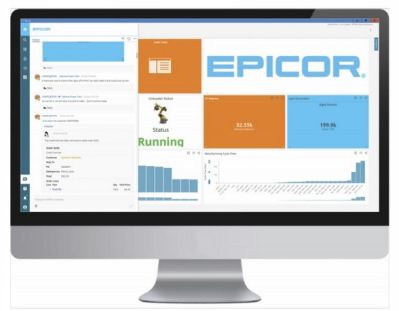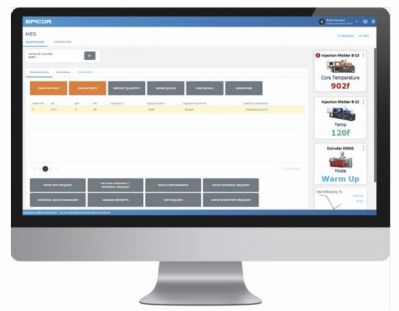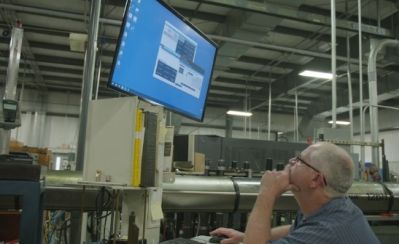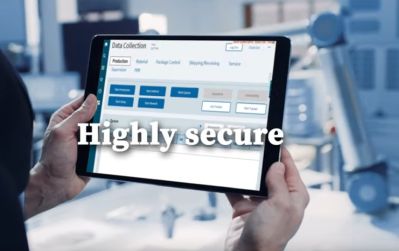Here's One Innovative Technology to Help Metalworkers Compete in the New Now (Watch Video)
Like all industries, the metalworking industry looks a bit different from the way it did when the pandemic started eighteen months ago. This is the new now, and companies must adapt if they want to flourish. Epicor's product marketing manager, Christine Hansen, writes about one key technology that can drive greater performance for greater success in the future.
For welders, metal fabricators, metal cutters, and everyone in the machine tool industry, the need to strengthen customer relationships and drive value in new, innovative ways continues. Expectations are evolving around responsiveness to change and accountability in areas like sourcing materials and ensuring strong employee health.

As the workforce continues to look and feel different, investments in technology to support remote collaboration, mobile (and remote) workers, and business-to-business eCommerce portals that offer self-service oversight on job or shipment status both reduce costs and shorten time-to-market. Metal fabricator Dalsin Industries understands this and the value that evolving technology delivers.
"Some of the most significant challenges we face are increasing customer demands from the standpoint of technical ability, documentation, and service lead-time being reduced, but yet wanting it all for less," said Keith Diekmann, Vice President of Technical Operations, Dalsin Industries. "It's very competitive out in the market today, so we must maintain our competitiveness through technology to reduce costs and time-to-market."

Communication across an extended remote workforce can be difficult but has proven necessary to continue to deliver a high level of experience to customers. Digital collaboration tools offer enhanced messaging capabilities for the business that allows employees to communicate with hashtags and @ symbols, two widely used social tools.
Additionally, businesses can integrate enterprise resource planning (ERP) events into message streams and build cross-functional teams that can solve problems quickly, reducing the clutter of emails, unnecessary notifications, and status update meetings. Everyone can easily be on the same page on a customer order, problem job, or ongoing project, even if the team is not physically together.
VIDEO: Epicor's new Kinetic, the cloud ERP built with manufacturers, for manufacturers.
With businesses like Amazon seemingly competing against all industries, time-to-market from the point of order to shipment continues to be squeezed and shortened.
In response, manufacturers are deploying online commerce solutions where customers can initiate quote requests, order repeat items, and even configure standard products for pricing right from a company's website.

Integrated to backend production systems, these configurations and orders are automatically transferred, validated, and sent to procurement or directly to production based on available schedules. Customers prefer the simplicity of electronic commerce solutions that allow them to quickly check on the status or review their account, especially during a time of such unease.
Reducing risk in the supply chain is also a high priority for customers who are now asking for greater insight into sourcing and alternative sourcing where available. The ability to deliver is now top of mind, especially when sourcing materials from certain regions of the world where delays in product or shipping may have occurred in the past.
Also, closely managing suppliers from a quality and delivery perspective with scorecards and systems that support supplier audits and supplier corrective action requests not only offers benefits to the business, but it also demonstrates the rigor customers are looking for in trusted suppliers. Deploying quality management systems (QMS) can help achieve these goals alongside the reduced cost of quality.

QMS reduces the cost of quality across the enterprise by introducing standardized workflow for manufacturers that meets industry standards for compliance. This is critical in many industries for entry, but for others, the rigor of quality systems can provide a strong basis for reduced waste.
Secondly, as many manufacturers look to deploy quality, a natural benefit is in the management of documentation that may be scattered. Understanding standard processes with strong documentation offers a critical tool when nonstandard events such as a returned item happen and the employee who does that is on vacation or moved to another department to fill in for someone else. It drives a level of operational flexibility that is needed by businesses today to stay afloat against competitors. Quality systems also deliver a level of traceability that reduces time spent looking for or into what transpired. The audit trail is available for easy access.
Lastly, customer interactions take a new tone as your customer service team is armed with accurate quality data when responding to reports of quality problems.
Greater Operational Performance with Complete ERP
Operationally, businesses continue to focus on doing more with less, improving operational productivity across the value chain while reducing overall costs. Traditional strategies of going paperless, continuous improvement programs, and digital transformation are initiatives that once offered incremental advantages.

Now, however, as the majority of manufacturers are well on their journeys and competing at new levels, digital transformation is deepening across more processes. For many businesses, deployment of electronic content management, manufacturing execution systems (MES), and Industry 4.0 technologies that drive new efficiencies for shop workers and offer greater equipment effectiveness translate to reduced costs and provide a path to offering greater value-added services for greater profits.
Outside the clutter that paper introduces, the "point-in-time" nature of paper-based processes means when things change, which is more likely than not to happen, the paper will need to be replaced with a new one. Going paperless, deploying electronic records instead of job packets with paper drawings and manually signed work orders, declutters operations.
There are also many benefits to these digital processes that go beyond just going paperless on the plant floor. Alongside the environmental benefits of going electronic, operators can more easily receive queues of work from their MES and always know what is coming next in production. This wasn't as seamless before paperless options were available.

Nowadays, workers aren't walking around looking for something to do or someone to ask what to do. Work is accurately logged with the time it took and the quantity completed, which helps to drive more informed estimates the next time around and delivers greater accountability around the cost of production.
Beyond worker-driven MES, Industry 4.0 or the internet of things (IoT) technologies connect equipment notifications directly to ERP systems where the notifications can be filtered to what the business cares about.
For example, the business employees may not care about every weld joint being completed, but they may be concerned about the weld joint that failed. They would likely care more about the pieces of equipment that aren't running or that will soon need to be repaired. Keeping capital investments running optimally helps drive new levels of efficiency and productivity and reduces the cost of production, which are crucial during a time like this.
Getting Current and Staying Current is Easy in the Cloud
Manufacturers on older ERP technology are quickly seeing they are at a disadvantage to compete. The path of least resistance and minimal cost for many businesses is to upgrade their technology and take advantage of what their vendor has to offer in the latest releases.

For some that are many releases behind, the cloud offers a clear solution and is an opportunity to resolve the sins of the past and forge a new path forward. This is especially true when considering the cost of software updates, new hardware servers, and vendor contracts for installation and management of systems.
Cloud continues to perform for businesses with limited IT budgets to ensure the security and sustainability of current systems. One of the values of the cloud that manufacturers who leverage the technology speak to consistently is that staying current delivers value in taking advantage of the latest innovative technology as it becomes available, and never again will the business have the disruption of a costly upgrade.
Conclusion
Many businesses have spent the last several months pulling together resources to take on the unknown. What we do know, however, is that resilient businesses with agile technology will continue to compete strongly and win business. Serving customers at new levels, reducing costs to maximize margins, and delivering on expectations consistently will yield results.
This is the new now -- and this is the time to consider your technology journey. What will your operation look like in 6 -- 12 months? What part does technology play in your success? These are questions top of mind for many manufacturers, and they will ultimately determine who is successful in the long run.
Want more information? Click below.
Rate this article
View our terms of use and privacy policy ::m::